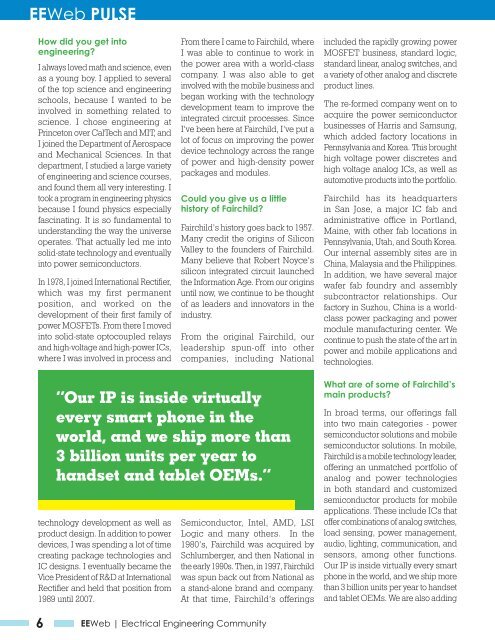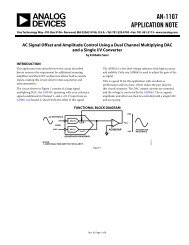DDR4 Design Considerations - EEWeb
DDR4 Design Considerations - EEWeb
DDR4 Design Considerations - EEWeb
You also want an ePaper? Increase the reach of your titles
YUMPU automatically turns print PDFs into web optimized ePapers that Google loves.
<strong>EEWeb</strong> PULSE INTERVIEW<br />
How did you get into<br />
engineering?<br />
I always loved math and science, even<br />
as a young boy. I applied to several<br />
of the top science and engineering<br />
schools, because I wanted to be<br />
involved in something related to<br />
science. I chose engineering at<br />
Princeton over CalTech and MIT, and<br />
I joined the Department of Aerospace<br />
and Mechanical Sciences. In that<br />
department, I studied a large variety<br />
of engineering and science courses,<br />
and found them all very interesting. I<br />
took a program in engineering physics<br />
because I found physics especially<br />
fascinating. It is so fundamental to<br />
understanding the way the universe<br />
operates. That actually led me into<br />
solid-state technology and eventually<br />
into power semiconductors.<br />
In 1978, I joined International Rectifier,<br />
which was my first permanent<br />
position, and worked on the<br />
development of their first family of<br />
power MOSFETs. From there I moved<br />
into solid-state optocoupled relays<br />
and high-voltage and high-power ICs,<br />
where I was involved in process and<br />
From there I came to Fairchild, where<br />
I was able to continue to work in<br />
the power area with a world-class<br />
company. I was also able to get<br />
involved with the mobile business and<br />
began working with the technology<br />
development team to improve the<br />
integrated circuit processes. Since<br />
I’ve been here at Fairchild, I’ve put a<br />
lot of focus on improving the power<br />
device technology across the range<br />
of power and high-density power<br />
packages and modules.<br />
Could you give us a little<br />
history of Fairchild?<br />
Fairchild’s history goes back to 1957.<br />
Many credit the origins of Silicon<br />
Valley to the founders of Fairchild.<br />
Many believe that Robert Noyce’s<br />
silicon integrated circuit launched<br />
the Information Age. From our origins<br />
until now, we continue to be thought<br />
of as leaders and innovators in the<br />
industry.<br />
From the original Fairchild, our<br />
leadership spun-off into other<br />
companies, including National<br />
“Our IP is inside virtually<br />
every smart phone in the<br />
world, and we ship more than<br />
3 billion units per year to<br />
handset and tablet OEMs.”<br />
technology development as well as<br />
product design. In addition to power<br />
devices, I was spending a lot of time<br />
creating package technologies and<br />
IC designs. I eventually became the<br />
Vice President of R&D at International<br />
Rectifier and held that position from<br />
1989 until 2007.<br />
Semiconductor, Intel, AMD, LSI<br />
Logic and many others. In the<br />
1980’s, Fairchild was acquired by<br />
Schlumberger, and then National in<br />
the early 1990s. Then, in 1997, Fairchild<br />
was spun back out from National as<br />
a stand-alone brand and company.<br />
At that time, Fairchild’s offerings<br />
included the rapidly growing power<br />
MOSFET business, standard logic,<br />
standard linear, analog switches, and<br />
a variety of other analog and discrete<br />
product lines.<br />
The re-formed company went on to<br />
acquire the power semiconductor<br />
businesses of Harris and Samsung,<br />
which added factory locations in<br />
Pennsylvania and Korea. This brought<br />
high voltage power discretes and<br />
high voltage analog ICs, as well as<br />
automotive products into the portfolio.<br />
Fairchild has its headquarters<br />
in San Jose, a major IC fab and<br />
administrative office in Portland,<br />
Maine, with other fab locations in<br />
Pennsylvania, Utah, and South Korea.<br />
Our internal assembly sites are in<br />
China, Malaysia and the Philippines.<br />
In addition, we have several major<br />
wafer fab foundry and assembly<br />
subcontractor relationships. Our<br />
factory in Suzhou, China is a worldclass<br />
power packaging and power<br />
module manufacturing center. We<br />
continue to push the state of the art in<br />
power and mobile applications and<br />
technologies.<br />
What are of some of Fairchild’s<br />
main products?<br />
In broad terms, our offerings fall<br />
into two main categories - power<br />
semiconductor solutions and mobile<br />
semiconductor solutions. In mobile,<br />
Fairchild is a mobile technology leader,<br />
offering an unmatched portfolio of<br />
analog and power technologies<br />
in both standard and customized<br />
semiconductor products for mobile<br />
applications. These include ICs that<br />
offer combinations of analog switches,<br />
load sensing, power management,<br />
audio, lighting, communication, and<br />
sensors, among other functions.<br />
Our IP is inside virtually every smart<br />
phone in the world, and we ship more<br />
than 3 billion units per year to handset<br />
and tablet OEMs. We are also adding<br />
MEMS inertial sensors to our portfolio<br />
of mobile offerings.<br />
In our power portfolio, we have<br />
devices that start at about 12-volts<br />
and go to about 1400-volts. This<br />
includes one of the main families, our<br />
PowerTrench(R) MOSFETs, which<br />
are lower voltage devices in the under<br />
200-volt range. We have a MOSFET<br />
technology that few other companies<br />
have, called shielded-gate technology,<br />
which greatly improves the power<br />
density, switching performance, and<br />
efficiency of trench power MOSFETs.<br />
That’s definitely an area of a lot of<br />
interest. In higher voltage areas, we<br />
have a strong lineup of super junction<br />
MOSFETs in the 600-650V range.<br />
In addition, we have some leading<br />
technologies in AC to DC converters<br />
up to 1 kilowatt, and motor drives<br />
up to 5 kilowatts. For higher power<br />
levels, we have our IGBTs. We’ve got<br />
a variety of technologies there—our<br />
latest technology is called field stop<br />
technology. We have leading edge<br />
performance in 600- to 1200-volt<br />
IGBTs for motor drives, renewable<br />
energy, and industrial and automotive<br />
power train applications.<br />
We are a leading supplier of power<br />
modules that use direct bonded<br />
copper on ceramic and transfer<br />
molded packaging technology. This<br />
technology allows us to manufacture<br />
SPM® smart power modules that<br />
include drive, sense, and protection<br />
features as well as power—with<br />
highly robust cycling performance<br />
and excellent thermal characteristics.<br />
Recently, we announced our newest<br />
technology, silicon carbide. Silicon<br />
carbide technology will be part of the<br />
next generation of power systems,<br />
allowing more power in less space<br />
and the ability to deliver more<br />
performance per unit cost.<br />
For more than 50 years Fairchild<br />
Semiconductor has focused on<br />
“Our largest core mission<br />
concerning energy efficiency<br />
is something that we get very<br />
excited about and we value<br />
the contribution that makes<br />
to society in general.”<br />
customer success. Our commitment<br />
to their success drives us to design,<br />
manufacture, and supply power and<br />
mobile semiconductor technologies<br />
to make home appliances more<br />
energy efficient, enable mobile<br />
device manufacturers to deliver<br />
innovative new features, and boost<br />
the efficiency of industrial products.<br />
Our semiconductor solutions for<br />
automotive, mobile, LED lighting,<br />
and power management applications<br />
help our customers achieve success<br />
every day.<br />
What kinds of products are<br />
you targeting for your silicon<br />
carbide technology?<br />
The device that we led with is a 1200volt<br />
bipolar transistor. We selected<br />
the bipolar transistor to start with<br />
because it has the lowest conduction<br />
loss of any technology, so we can<br />
get the most current out of a given<br />
chip size. It switches extremely<br />
fast—as fast as any device currently<br />
can—so it can also operate at a<br />
relatively high frequency for highpower<br />
applications. Normally, these<br />
applications may run at 5 or 10 KHz,<br />
but with these silicon carbide bipolar<br />
transistors, we can actually take that<br />
up to 30, 40, 50, even 100 KHz in some<br />
applications. We will offer diodes that<br />
complement these transistors, and<br />
we package them in plastic, high<br />
temperature discrete, and power<br />
module packages.<br />
Is there additional drive<br />
circuitry required to implement<br />
this new technology?<br />
Yes. Most designers are not used to<br />
driving bipolar transistors because<br />
they require an input current. One<br />
of the good things about this silicon<br />
carbide technology, compared to<br />
what people remember in silicon<br />
bipolar technology, is that the current<br />
gain is very high, so you don’t have to<br />
put that much current into the base<br />
to get what you want out—the gains<br />
are in the range of 100, typically. The<br />
power loss is not a very big factor—<br />
it’s about a tenth of a percent of the<br />
output power. People do need to<br />
remember how to drive the base of<br />
a power transistor because many are<br />
used to drive MOSFETs and IGBTs,<br />
which are voltage-controlled.<br />
Do you have app notes<br />
or other resources to help<br />
engineers who aren’t familiar<br />
with using these transistors?<br />
Specific to silicon carbide technology,<br />
we have resources from applications<br />
notes, reference designs, evaluation<br />
boards and starter kits, to field<br />
6 <strong>EEWeb</strong> | Electrical Engineering Community<br />
Visit www.eeweb.com<br />
7















